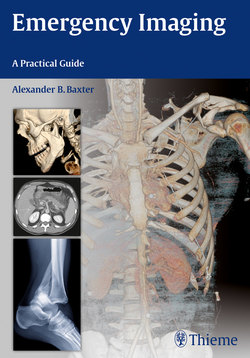Читать книгу Emergency Imaging - Alexander B. Baxter - Страница 113
На сайте Литреса книга снята с продажи.
Оглавление101
3 Head and Neck
physema and potential medial rectus mus-cle entrapment, which can lead to diplopia on lateral gaze.
Orbital roof fractures are uncommon, and most are due to extension from fron-tal and calvarial fractures in major head injury.
CT defines the area and location of the fracture as well as any fragment displace-ment. Orbital fat herniation, extraocular muscle entrapment, and infraorbital canal involvement are easily identified. Muscle entrapment is evident clinically by diplo-pia on horizontal or vertical gaze, and cor-responding CT findings include an acute change in the angle of the muscle as it passes through the orbit or impalement of one of the muscles on a bone spicule. Intra-orbital emphysema and retroseptal intra-orbital or subperiosteal hematoma should be sought, as the former indicates risk of orbital infection and the latter may lead to increased intraorbital pressures, with secondary globe ischemia or optic nerve damage.
Surgical intervention is usually indicatedfor severe fractures to prevent late enoph-thalmos and diplopia. Emergent surgicalindications include symptomatic bradycar-dia and large orbital hematoma (Fig. 3.8).
◆Orbital Wall Fractures
Orbital wall fractures may be due to exten-sion from a calvarial or skull base fracture, or they can follow direct impact from a fist or a ball to the eye socket. In this case an abrupt increase in intraorbital pressure leads most commonly to orbital floor fail-ure with variable orbital fat herniation, in-ferior rectus or oblique muscle entrapment, orbital emphysema, and intrasinus hemor-rhage. These are often referred to as orbital blowout fractures. Clinical findings, when present, include restricted upward and lat-eral gaze, subcutaneous emphysema, and diminished sensation in the distribution of the infraorbital nerve (V2). Enophthalmos is usually not evident acutely, but it can be seen in unrepaired fractures after initial swelling resolves. Rarely symptomatic bra-dycardia can result from stretching of the infraorbital nerve (oculocardiac reflex).
Medial orbital wall, or lamina papyra-cea, fractures often occur in conjunction with floor fractures, but isolated medial wall fractures are much less common than floor fractures or combinations. Most medial orbital wall fractures are small, of little consequence, and discovered on CT obtained for other indications long after an injury. When symptomatic, medial wall fractures are associated with orbital em-
Fig. 3.8a–fa,b Orbital oor fracture. Right orbital oor fracture with depression of the lateral orbital oor. The infra-orbital canal (V2 branch) is intact. Intraorbital air and intrasinus hemorrhage.
c,d Medial orbital wall fracture. Left posterior medial orbital wall fracture with intraorbital emphysema and fat and medial rectus herniation into the posterior ethmoid air cells. The medial rectus is tethered at the anterior margin of the fracture.
e,f Orbital roof fracture. Left orbital roof fracture with extension into aerated frontal sinus. Superior orbital extraconal hematoma and orbital emphysema.
